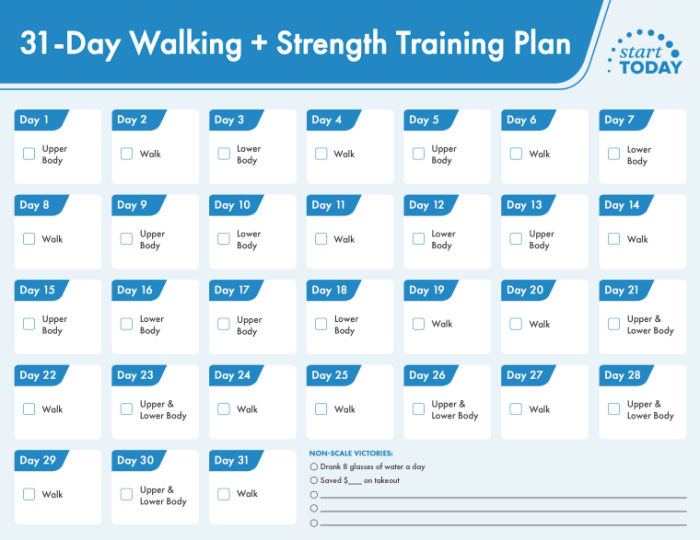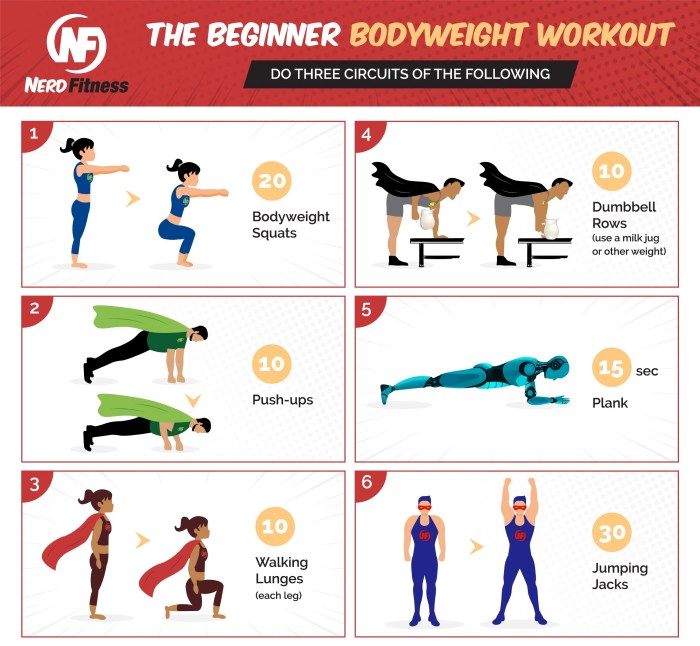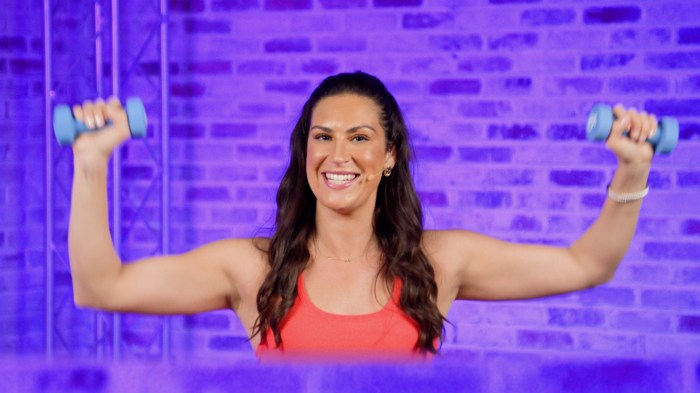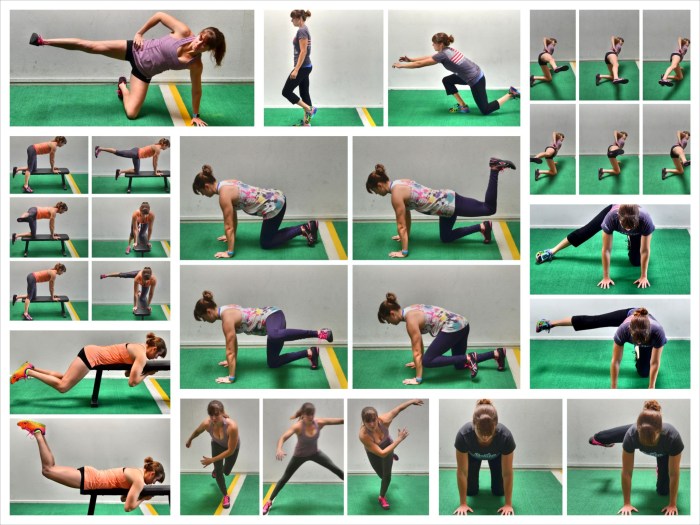In the realm of fitness, quick strength training workouts emerge as a game-changer, offering an effective and efficient solution for those seeking to enhance their strength and overall well-being. This guide delves into the world of quick strength training workouts, exploring their benefits, structure, exercises, and progression strategies to empower you with the knowledge and tools to achieve your fitness goals.
Whether you’re a seasoned athlete or just starting your fitness journey, quick strength training workouts can be tailored to meet your individual needs and help you unlock your full potential. Join us as we embark on this transformative journey, where strength and efficiency converge to deliver exceptional results.
Exercises for a Quick Strength Training Workout

Incorporating strength training into your fitness routine is crucial for overall health and well-being. Here are five effective exercises that you can perform for a quick and efficient strength training workout:
Squats
- Stand with your feet hip-width apart and toes slightly turned out.
- Lower your body by bending your knees and hips as if sitting back into a chair.
- Keep your chest up and your knees aligned with your toes.
- Return to the starting position by extending your knees and hips.
Push-ups
- Start in a plank position with your hands shoulder-width apart and your body forming a straight line from head to heels.
- Lower your body by bending your elbows and keeping your back straight.
- Push back up to the starting position by extending your elbows.
Lunges
- Step forward with one leg and bend both knees, lowering your body until your front thigh is parallel to the ground.
- Keep your front knee aligned with your ankle and your back knee close to the ground.
- Push back to the starting position by extending your front leg.
Rows
- Hold a dumbbell or kettlebell in each hand and stand with your feet shoulder-width apart.
- Bend forward at the hips and knees, keeping your back straight.
- Pull the weights up towards your chest, keeping your elbows close to your body.
- Lower the weights back to the starting position.
Plank
- Start in a plank position with your forearms on the ground and your body forming a straight line from head to heels.
- Hold this position for as long as possible, engaging your core muscles.
Sample Quick Strength Training Workout Plan
This plan provides a comprehensive workout that targets multiple muscle groups and can be completed in under 30 minutes. It includes warm-up, exercises, and cool-down phases, with specific sets, repetitions, and rest times for each exercise.
Warm-up
Begin with 5-10 minutes of light cardio, such as jogging or cycling, to elevate your heart rate and prepare your muscles for the workout. Follow with dynamic stretching, including arm circles, leg swings, and torso twists, to improve flexibility and range of motion.
Exercises
The workout consists of compound exercises that work multiple muscle groups simultaneously. Perform each exercise for the specified number of sets, repetitions, and rest time:
- Squats:3 sets of 10-12 repetitions, rest 60 seconds
- Push-ups:3 sets of 8-10 repetitions, rest 60 seconds
- Lunges:3 sets of 10-12 repetitions per leg, rest 60 seconds
- Rows:3 sets of 8-10 repetitions, rest 60 seconds
- Plank:Hold for 30-60 seconds, rest 60 seconds
Cool-down
Finish the workout with 5-10 minutes of static stretching to improve flexibility and reduce muscle soreness. Hold each stretch for 15-30 seconds.
Workout Plan Summary
| Exercise | Sets | Repetitions | Rest Time |
|---|---|---|---|
| Squats | 3 | 10-12 | 60 seconds |
| Push-ups | 3 | 8-10 | 60 seconds |
| Lunges | 3 | 10-12 (per leg) | 60 seconds |
| Rows | 3 | 8-10 | 60 seconds |
| Plank | 1 | 30-60 seconds | 60 seconds |
Benefits of Quick Strength Training Workouts

Quick strength training workouts are a great way to improve your strength, muscle mass, and metabolism. They are also a time-efficient way to get a workout in, which makes them ideal for people with busy schedules.One of the benefits of quick strength training workouts is that they can help you to build muscle mass.
This is because they involve lifting weights or doing bodyweight exercises that challenge your muscles. When you challenge your muscles, they respond by getting stronger and growing in size.Another benefit of quick strength training workouts is that they can help you to improve your metabolism.
This is because they increase your muscle mass, which in turn helps you to burn more calories at rest. This can lead to weight loss and improved body composition.Quick strength training workouts can also help to improve your strength. This is because they involve lifting weights or doing bodyweight exercises that challenge your muscles.
When you challenge your muscles, they respond by getting stronger. This can lead to improved performance in everyday activities and sports.In addition to the benefits listed above, quick strength training workouts are also a great way to improve your mood and energy levels.
This is because they release endorphins, which have mood-boosting and pain-relieving effects.Here is a table comparing the benefits of quick strength training workouts to traditional strength training workouts:| Benefit | Quick Strength Training Workouts | Traditional Strength Training Workouts ||—|—|—|| Time efficiency | Yes | No || Muscle mass | Yes | Yes || Metabolism | Yes | Yes || Strength | Yes | Yes || Mood and energy levels | Yes | Yes |Here are some tips for getting the most out of quick strength training workouts:* Choose exercises that target multiple muscle groups.This will help you to save time and get a full-body workout.
- Use a weight that is challenging but not too heavy.You should be able to complete 10-12 repetitions of each exercise with good form.
- Focus on quality over quantity.It is more important to perform each exercise correctly than to do a lot of repetitions.
- Rest for 60-90 seconds between sets.This will give your muscles time to recover.
- Be consistent with your workouts.Aim to do quick strength training workouts 2-3 times per week.
Here is a sample quick strength training workout plan: Warm-up:* Jumping jacks: 30 seconds
High knees
30 seconds
Butt kicks
30 seconds Workout:* Goblet squats: 10-12 repetitions
Push-ups
10-12 repetitions
Rows
10-12 repetitions
Lunges
10-12 repetitions per leg
Plank
30 seconds Cool-down:* Static stretching: 30 seconds per stretch
Nutrition for Quick Strength Training Workouts

Nutrition plays a crucial role in optimizing performance and recovery during quick strength training workouts. Fueling the body appropriately before, during, and after workouts ensures adequate energy levels, muscle repair, and adaptation.
Pre-Workout Nutrition
- Consume a carbohydrate-rich meal or snack 1-2 hours before your workout to provide sustained energy.
- Include lean protein to support muscle protein synthesis and reduce muscle breakdown.
- Stay hydrated by drinking plenty of water before, during, and after your workout.
Intra-Workout Nutrition
- For workouts lasting longer than 60 minutes, consider consuming a sports drink or gel to replenish electrolytes and carbohydrates.
- Avoid consuming large meals or sugary drinks during workouts, as they can cause digestive distress.
Post-Workout Nutrition
- Consume a protein-rich meal or snack within 30-60 minutes after your workout to promote muscle repair and growth.
- Replenish carbohydrate stores by consuming fruits, vegetables, or whole grains.
- Stay hydrated by continuing to drink plenty of water.
Recovery from Quick Strength Training Workouts

Recovering adequately after quick strength training workouts is crucial for muscle growth, injury prevention, and overall fitness. Here’s how to promote muscle recovery and minimize the risk of setbacks.
Stretching:Regular stretching helps improve flexibility, range of motion, and blood flow to muscles, aiding in recovery. Hold each stretch for 15-30 seconds, focusing on major muscle groups.
Foam Rolling:Foam rolling involves applying pressure to muscles using a foam roller. It helps release muscle tension, improve circulation, and break down knots or adhesions.
Massage:Massage, whether self-massage or professional, can effectively reduce muscle soreness, improve flexibility, and promote relaxation. Focus on areas with tight or sore muscles.
| Method | Benefits | Drawbacks |
|---|---|---|
| Stretching | – Improves flexibility and range of motion
|
– May not be effective for deep muscle recovery
|
| Foam Rolling | – Releases muscle tension
|
– Can be painful or uncomfortable
|
| Massage | – Reduces muscle soreness
|
– Can be expensive
|
Warning Signs of Inadequate Recovery:
- Persistent muscle soreness or stiffness
- Decreased range of motion or flexibility
- Fatigue or lethargy
- Sleep disturbances
- Increased risk of injury
Recovery Video Script:
Narrator:“To optimize recovery from quick strength training workouts, incorporate the following techniques into your routine: – Perform static stretches for major muscle groups, holding each for 15-30 seconds. – Use a foam roller to apply pressure to tight or sore muscles, focusing on rolling movements.
– Consider self-massage or professional massage to reduce muscle soreness and improve flexibility. – Get adequate sleep and nutrition to support muscle recovery. – Pay attention to your body’s signals and rest when necessary. By following these tips, you can promote muscle recovery, prevent injuries, and maximize the benefits of your workouts.”
Progression in Quick Strength Training Workouts
Progression in quick strength training workouts is crucial to continually challenge your muscles and achieve optimal results. Here’s how you can gradually increase the intensity and difficulty:
Weight or Resistance
As you get stronger, you need to gradually increase the weight or resistance you’re using. This can be done by adding more weight to your exercises or using resistance bands with higher resistance levels.
Sets and Reps
Once you can comfortably perform a certain number of sets and reps with a particular weight or resistance, you can increase the volume by adding more sets or reps. This will help you build more muscle and strength.
Tempo
Tempo refers to the speed at which you perform an exercise. By slowing down the tempo, you can increase the time under tension and make the exercise more challenging. This is especially effective for building muscle mass.
Rest Periods, Quick strength training workout
Reducing the rest periods between sets can increase the intensity of your workouts and help you burn more calories. However, it’s important to listen to your body and rest when needed to avoid overtraining.
Exercise Selection
As you progress, you can incorporate more challenging exercises into your workouts. This could include exercises that target multiple muscle groups or require more complex movements.
Frequency
If you’re not seeing results, you may need to increase the frequency of your workouts. However, it’s important to allow for adequate recovery time between workouts to avoid overtraining.
Challenges of Quick Strength Training Workouts
Quick strength training workouts offer many benefits, but they also come with some challenges.One challenge is the potential for injury if the exercises are not performed correctly. It is important to learn proper form and technique before starting any strength training program.Another challenge is that quick strength training workouts can be difficult to fit into a busy schedule.
However, there are many ways to make these workouts more convenient, such as doing them at home or during your lunch break.Finally, quick strength training workouts can be boring if they are not varied. There are many different exercises that can be included in a quick strength training workout, so it is important to find ones that you enjoy and that challenge you.
Overcoming Challenges
There are a few things you can do to overcome the challenges of quick strength training workouts.* To avoid injury, start slowly and gradually increase the intensity and duration of your workouts.
- To make your workouts more convenient, find a time and place that works for you and stick to it.
- To keep your workouts interesting, vary the exercises you do and challenge yourself with new ones.
Summary
Quick strength training workouts offer many benefits, but they also come with some challenges. By following these tips, you can overcome these challenges and make the most of your workouts.
Last Word

As you incorporate quick strength training workouts into your routine, you’ll witness a remarkable transformation in your strength, muscle mass, and overall health. Remember, consistency and proper technique are key to unlocking the full benefits of this powerful training method.
Embrace the challenge, stay committed, and experience the profound impact that quick strength training workouts can have on your fitness journey.
Essential Questionnaire
How often should I perform quick strength training workouts?
For optimal results, aim for 2-3 quick strength training workouts per week, with at least 48 hours of rest between sessions to allow for muscle recovery.
What’s the ideal duration for a quick strength training workout?
Keep your workouts concise and efficient, targeting 15-20 minutes per session. This focused approach maximizes effectiveness while minimizing time commitment.
Is quick strength training suitable for beginners?
Absolutely! Quick strength training workouts can be adapted to all fitness levels. Start with a beginner-friendly plan and gradually increase intensity as you progress.
Leave a Reply